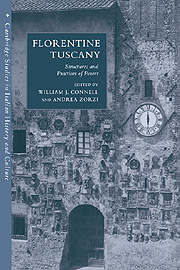Book contents
- Frontmatter
- Contents
- List of figures
- List of tables
- List of abbreviations of archival sources
- Introduction
- 1 The ‘material constitution’ of the Florentine dominion
- 2 The language of empire
- 3 Constitutional ambitions, legal realities and the Florentine state
- 4 Fiscality, politics and dominion in Florentine Tuscany at the end of the middle ages
- 5 Market structures
- 6 State-building, church reform and the politics of legitimacy in Florence, 1375–1460
- 7 The humanist citizen as provincial governor
- 8 Territorial offices and officeholders
- 9 Demography and the politics of fiscality
- 10 Florentines and the communities of the territorial state
- 11 Patronage and its role in government: the Florentine patriciate and Volterra
- 12 San Miniato al Tedesco: the evolution of the political class
- 13 The social classes of Colle Valdelsa and the formation of the dominion (fourteenth–sixteenth centuries)
- 14 Arezzo, the Medici and the Florentine regime
- 15 Rubrics and requests: statutory division and supra-communal clientage in Pistoia
- 16 A comment
- Index
- CAMBRIDGE STUDIES IN ITALIAN HISTORY AND CULTURE
8 - Territorial offices and officeholders
Published online by Cambridge University Press: 16 September 2009
- Frontmatter
- Contents
- List of figures
- List of tables
- List of abbreviations of archival sources
- Introduction
- 1 The ‘material constitution’ of the Florentine dominion
- 2 The language of empire
- 3 Constitutional ambitions, legal realities and the Florentine state
- 4 Fiscality, politics and dominion in Florentine Tuscany at the end of the middle ages
- 5 Market structures
- 6 State-building, church reform and the politics of legitimacy in Florence, 1375–1460
- 7 The humanist citizen as provincial governor
- 8 Territorial offices and officeholders
- 9 Demography and the politics of fiscality
- 10 Florentines and the communities of the territorial state
- 11 Patronage and its role in government: the Florentine patriciate and Volterra
- 12 San Miniato al Tedesco: the evolution of the political class
- 13 The social classes of Colle Valdelsa and the formation of the dominion (fourteenth–sixteenth centuries)
- 14 Arezzo, the Medici and the Florentine regime
- 15 Rubrics and requests: statutory division and supra-communal clientage in Pistoia
- 16 A comment
- Index
- CAMBRIDGE STUDIES IN ITALIAN HISTORY AND CULTURE
Summary
This chapter aims to provide stimulus to a debate already under way concerning the identities, activities, social origins and careers of the officials who administered the Florentine territory in the decades from the late fourteenth to the mid-fifteenth century. This was precisely the period that witnessed the intensification and fulfillment of a process whereby, over the forty years from Florence's acquisition of Arezzo in 1384 to that of Livorno in 1421, the Florentine territorial state attained the basic configuration it would retain down to the mid-sixteenth century. The study will discuss the composition of the body of officials who were dispatched by the state to administer the territory, their social and professional backgrounds, and Florentine attitudes towards them and towards the subject communities they were sent out to govern.
The territorial state that took shape at the end of the fourteenth and beginning of the fifteenth century retained many institutional characteristics of the fourteenth-century Florentine state, particularly the markedly Florentine composition of its corps of territorial officers. Such a state was a product both of a predilection for ambitious projects that characterised Florence's rulers during the Albizzi regime, as well as of long-standing debates and creative encounters with subject communities, which retained a lively desire to preserve intact the privileges and fiscal immunities contained in their original pacts of submission.
- Type
- Chapter
- Information
- Florentine TuscanyStructures and Practices of Power, pp. 165 - 182Publisher: Cambridge University PressPrint publication year: 2000



